Product teams are often working in parallel, meaning they have their own scrum teams that they work with on a daily basis, but how do they interact with other product managers? How do they keep each other informed on their team’s work? How do they get the feeling of being part of a product management team?
In order to bring a strong product team together, they need to have a shared understanding of their activities and responsibilities, as well as having shared goals and visions for how the product should be created and managed in their organisation.
Jon R. Katzenbach & Douglas K. Smith discuss these challenges on The Discipline of Teams in the Harvard Business Review (1993) and in their book “The Wisdom of Teams: Creating the High-Performance Organization”.
Goals help a team keep track of progress, while a broader purpose supplies meaning and emotional energy.- Jon R. Katzenbach & Douglas K. Smith
A great example of product managers guiding cross-team relationships can be found at Piktochart, where they describe the core ideals for successful collaboration are based on:
- Mutual respect and appreciation
- A common goal and overall vision
- A common vocabulary
Having this commonality documented will help to bring a basic level of understanding between all product managers. These product managers may not work with each other on a daily basis, but do collaborate on certain projects throughout the year.
Creating shared documentation, like a team or department manifesto, is a great way to record the common goals, shared vision and responsibility.
Armed with a manifesto that voices your values, you can ensure team culture is aligned. When your team acknowledges and ratifies the manifesto, all team members know what’s expected of them, and they know what they can rely on their teammates for.
A team manifesto is a document that can highlight:
- Behaviours that embody your shared team values and purpose
- How you work together
- What you do and do not stand for
- How you hold each other accountable to remain a united front
The team manifesto is a commitment to one another, defining what you’re moving toward together and giving you permission to hold each other accountable along the way.
When you have a defined manifesto that your team believes in, you’re able to:
- Make consistent decisions
- Bring more cohesiveness to relationships between one another
- Trust each other to respectfully challenge, debate and persist through obstacles
A team manifesto can come in many forms and, however you decide to document it, it needs to be easily accessible so that the team can reference the manifesto whenever they need.
I would like to take some time here to explain the steps that my team and I took to reach our manifesto, and what we did to share throughout our organisation. The hope is that this will give you a basic framework for you and your team to bounce off of and create your own manifesto.
How did we do it?
Start off by researching other team manifestos. From the manifestos you find, gather a list of key categories that could be relevant to your team, such as Measuring Success, Helping the Team, Trust and Respect.
Example of Team Manifestos found online
The next step is to select the categories to included in the team manifesto, an activity best done collaboratively. Together with my team, we identified the following the categories for our manifesto: Roles & Responsibilities, Goals, Values, Measure Success, How we work & How do we become a strong product team.
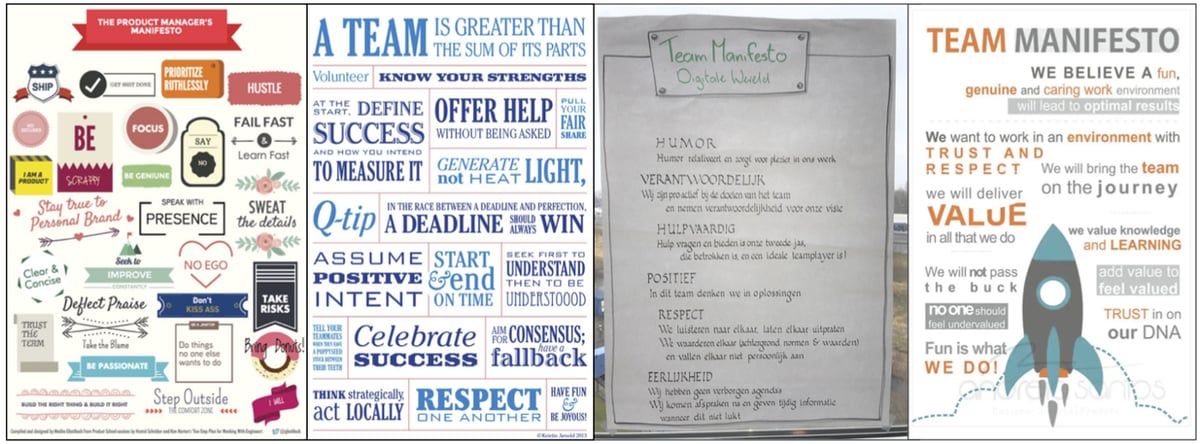
The next step is to select the categories to included in the team manifesto, an activity best done collaboratively. Together with my team, we identified the following the categories for our manifesto: Roles & Responsibilities, Goals, Values, Measure Success, How we work & How do we become a strong product team.
To collect the content for the manifesto, I recommend using a collaboration tool such as Miro or Google Slides. This is so that each team member can add their input online, and then that input can be easily arranged, edited or removed from the manifesto board.
In Miro I setup a blank manifesto for the team to add their input.
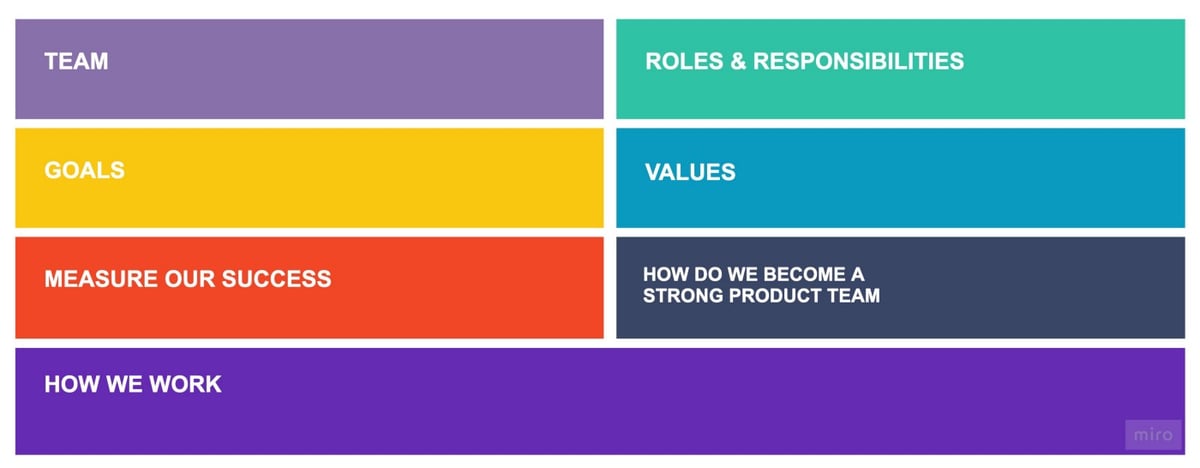
Want to learn about empowering product teams and how it could help your career? Book a free introduction call with Yoav (me, the author of this post) to explore together how mentorship can support your goals.
The list of categories are likely to be different for every team. You need to find what will (or will not!) fit your team. However, I do encourage you to always include Roles & Responsibilities, Goals, Values, and Measure Success. Just remember, as Jenn Lofgren says in her Forbes article “Manifestos only have power when people believe in and connect with them”.
Manifestos only have power when people believe in and connect with them
Gathering input
After setting up the manifesto with the empty categories it’s time to collect the input from the team. In keeping with the collaborative effort of a team manifesto, holding a workshop to develop the manifesto will be of great benefit. I would recommend gathering the team’s input (using tools of your choice) before the workshop, so that the team has time to think about what they would individually like the manifesto to stand for.
As Amelia Friedman suggests in her article Harvard Business Review article you need to “Give folks the opportunity to reflect and contribute thoughtfully.” This way they’ll come to find more meaning in the end result
Give folks the opportunity to reflect and contribute thoughtfully.
To gather the input I used a survey. You could do the same, or collect the input via face to face interviews, or a simple email. By using a survey you can frame the questions in a positive tone to fit the manifesto.
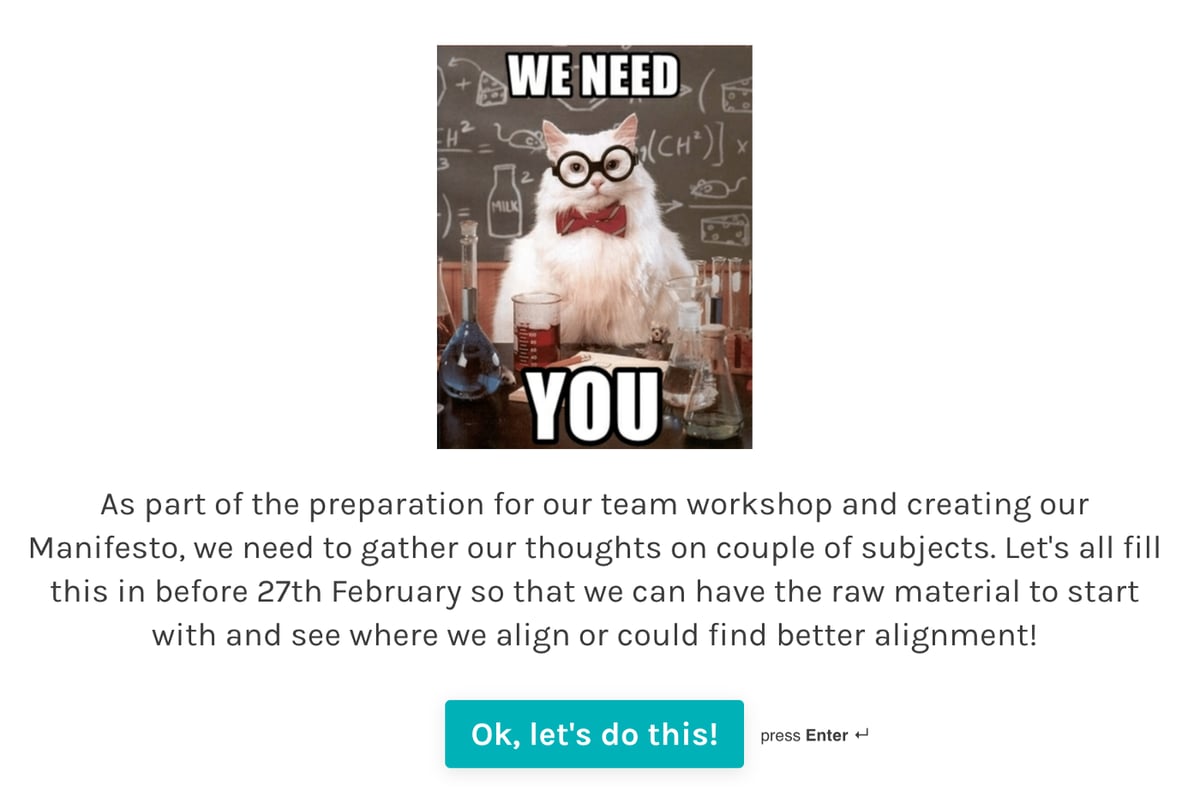
Once all the responses were in, I collated the results and grouped the feedback on digital post-it notes for the team to see, discuss and vote on (see image below for my example). During the workshop we had a chance to review and discuss the meaning and relevance of all responses. The next step was deciding as a team what Goals and Values were truly important to us.
Collective decision by voting!
During the workshop we removed, grouped and edited answers together, making sure we were all in agreement before making a change. This process took some time and during these discussions it was important to keep focus and on topic.
Once the team discussed all the items in the manifesto building block, it was time to vote!
Dotmocracy is a method for voting and decision making using dots. The methodology is part of the Hyper Island Toollbox. Dot voting is also used in design sprints for decision making. This method is easily applied both in virtual and digital workshops.
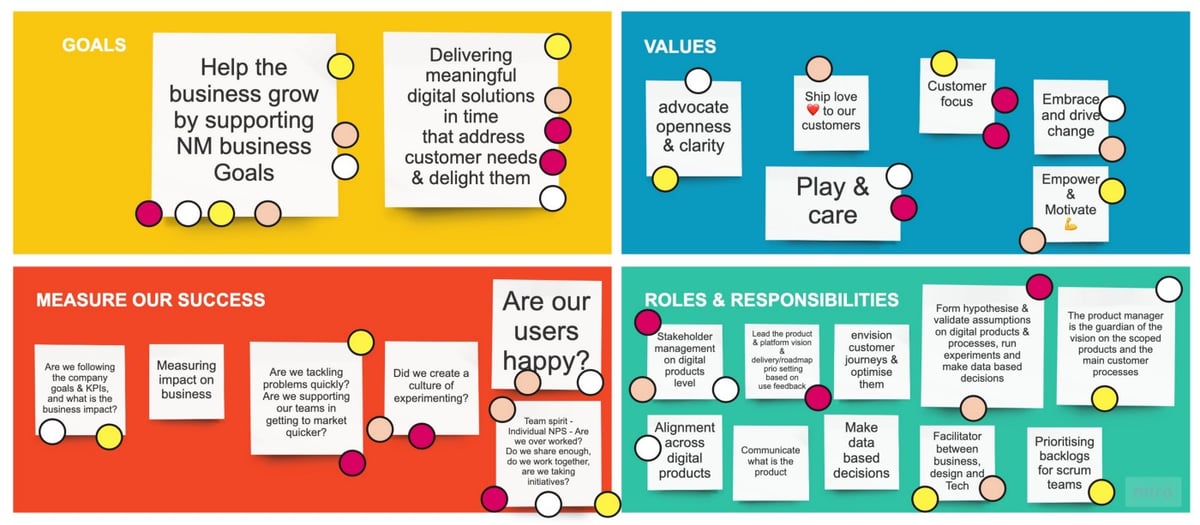
Each team member had 2 or 3 voting dots per building block, depending on the size of the building block. We then discussed the most voted on items in order to decide which of them were truly important enough for our manifesto.
In some cases we merged items, or rephrased them so that they are clear to us all. We were not too worried about how the items would sound to people outside the group reading our manifesto, our main aim was that it made sense to the team.
By the end of the workshop we had a narrowed down agreed upon list for every building block of the manifesto.
Presenting the building blocks
Now that you have consensus in your team over the building blocks of the manifesto you have completed the hardest stage! Congratulations 🎊
The next challenge is to make your team’s manifesto presentable to people outside of your team. This could be for colleagues within the organisation or for those outside the organisation. For example, it can be used it as something to show potential new starters to your team.
The first step we took was with this was to put the manifesto in a visual presentation, so it can easily be shared and understood. We wanted to focus on the language we used in the manifesto, ensuring that it was clear and precise and properly portrayed our sentiments.
Example: Our Values
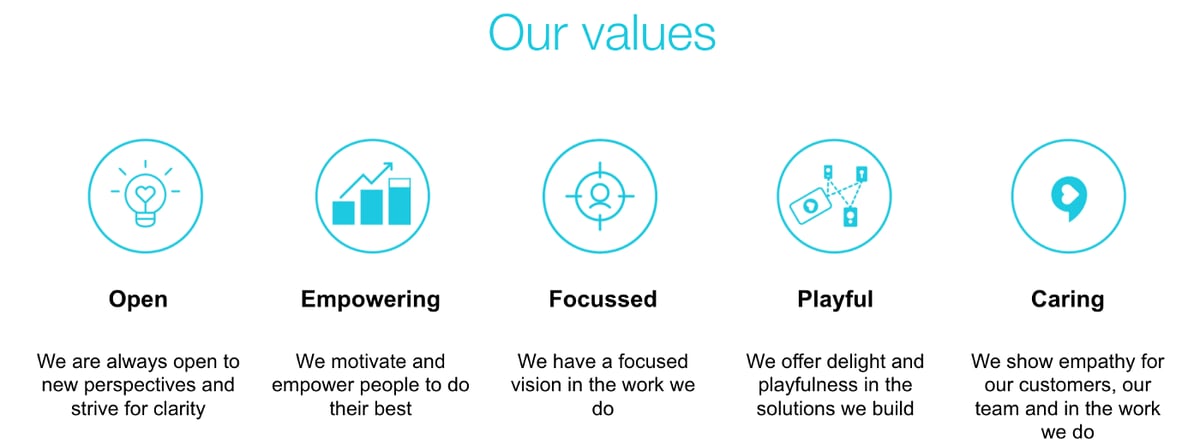
Example: Our responsibilities
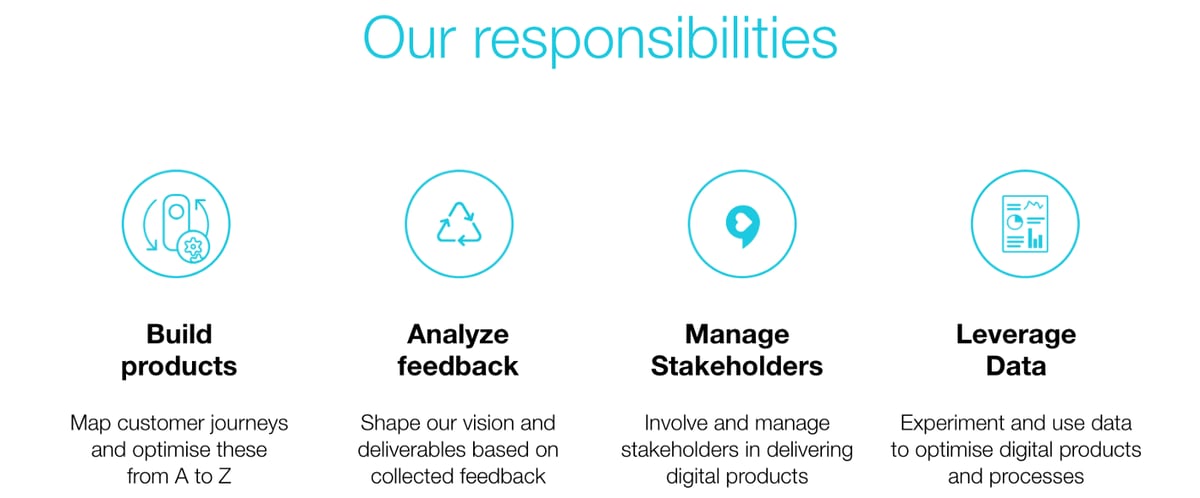
After the first draft of the presentation was ready, it was presented to the team. During the presentation some adjustments were made to make sure there was a consensus on manifesto’s wording and the presentation’s messaging.
Once the team is happy with the presentation, it was time to discussed how the manifesto could publicised within and outside the organisation.
Our ideas ranged from:
- Present in the presentation to the rest of the company
- Convert the manifesto to a poster to in order to make it easy to read
- Include some of it in our weekly meetings
- Involve other departments, and get them to contribute to the manifesto so more people within the organisation are engaged within.
- Publish articles about it (like this!)
- Have a section about it on our HR website to help with recruiting
If you have any other suggestions, please leave a get in touch 🙌
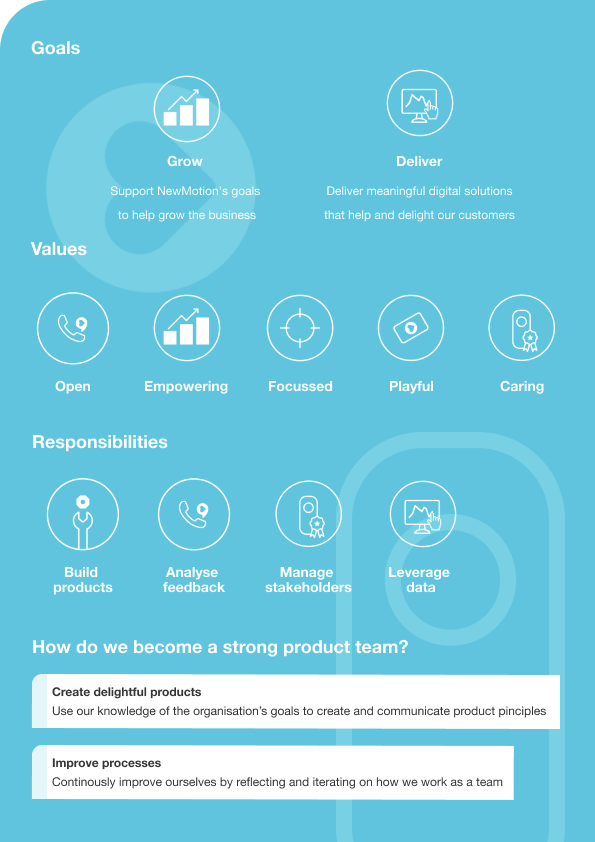
In order to keep the manifesto relevant
Guide our weekly meetings
In order to keep the manifesto relevant you can check in on your team values during team meetings.
Every week we go over our five values, (Openness, Empowerment, Focus, Playfulness and Care) and check how each team member is feeling they are fulfilling each value.
This is how we do it, you are welcome to take our guide or to create your own way of checking in on your values.
Review it regularly
It is important to keep going back to the manifesto regularly to make sure its content is still true to the team.
“Your team manifesto today may not work for the team you have in a year”.- Jenn Lofgren: Forbes
You need to keep in mind that it should be able to help the team make decisions and be aligned with how the team would like to work. This is something that does not need to be done weekly or monthly, our team finds that 3–4 times a year works well for us.
By updating and adjusting your team manifesto on a regular basis it stays front of mind for the team, it remains aligned with the changes occurring in the workplace, and it encourages the team to use it as a key resource.
Spread it wider!
Consider how you can expand the manifesto. Could the team manifesto be a department manifesto? Could a department manifesto be a manifesto for your entire organisation?
As the team becomes used to using the manifesto on a regular basis, you can involve other teams and departments in shaping it. Alternatively, you can use the team’s collective work to inspire other teams to make their own manifesto!
Remember that the inclusion of other voices or disciplines into your team manifesto could help enrich this living document, your team and your organisation. Creating a united and inclusive manifesto brings everyone to a level playing field when it comes to expectations, visions and goals.
To conclude, the benefits of creating a collaborative manifesto can be seen in action across many different aspects of work-life. Teams with joint manifestos have something to ground their work, their feeling of inclusivity and their trust in their team.
Teams with shared visions work harder together and can produce excellent results for themselves and their organisation. Making a team manifesto takes time, but I believe it is definitely time well spent.
If you like what you read and would like to be part of an empowered product team, get in touch with me, Yoav (the author of this article) with a free intro call to discover how mentorship can support your ambitions.







